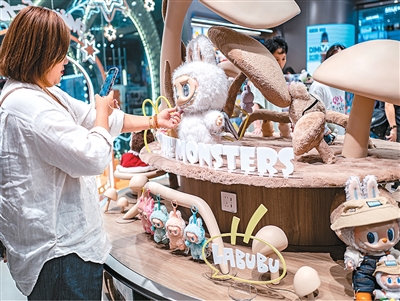A woman takes photos of dolls in a store of the Chinese toy company Pop Mart in Shanghai. (Photo/Wang Chu)
As the designer toy market continues to expand, doll clothing is rapidly becoming a must-have for collectors.
Doll outfits are not only popular among young consumers but also appeal to many parent-child families, office workers and other consumer groups.
“I initially bought dolls for my child, but then discovered that dressing up Labubu was fun, so I started buying doll clothes myself and often take photos to share with friends,” said Fang Jiayu, an office worker in Shanghai.
Recently, she purchased three sets of Labubu outfits at once, each priced at over 150 yuan ($21). Many stay-at-home mothers in their 30s and 40s around her are passionate about doll clothing.
On a leading e-commerce platform, a search for doll clothing yields products ranging from a dozen to several hundred yuan. Many top-ranked stores record monthly sales exceeding 1,000 units.
Data from one e-commerce platform shows that in 2024, doll clothing sales surged over 117.08 percent year on year. In May, sales grew even more notably, with single-month revenue surpassing 10 million yuan.
In Tongxiang, east China’s Zhejiang Province, orders have flooded into a doll clothing factory this year. The factory head explained that since May, the facility has ramped up production daily, with products selling not only across China but also in overseas markets.
Why are doll clothes so popular? The phrase “emotional value” is a key concept mentioned by many respondents. Ms. Zhao, a stay-at-home mother from Beijing, said that after finishing her daily tasks, changing her dolls’ clothes, posting on social media, and chatting with doll enthusiasts about styling tips provides excellent emotional relaxation.
Doll outfits are a catalyst for consumers’ social interaction, according to Pan Ji, a professor at Fudan University’s School of Journalism.
Doll clothing also provides substantial emotional value, Pan added. For many consumers, the process of dressing up dolls is highly stress-relieving, offering young people facing academic and work pressures an opportunity for self-expression, creation and emotional companionship.
On social platforms, individual sellers offer a diverse range of doll outfits to cater to various consumer needs.
In Yiwu, known as “the world’s supermarket” in Zhejiang Province, some garment manufacturers have recently begun producing custom clothing for dolls.
“We can make doll outfits featuring high-end embroidery, beading and other craftsmanship to increase product value. Many in the doll clothing business are able to create styles customized to customer requirements and sell them to Japan, South Korea, North America and other markets,” said the head of a manufacturer.
Pan sees the popularity of doll clothing as an opportunity for “guochao,” or China-chic — a fashion trend that combines modern designs with traditional cultural elements — to expand its presence internationally.
Some merchants are incorporating intangible cultural heritage fabrics and traditional Chinese elements into their doll clothing designs, receiving attention in overseas markets, Pan said.
The global designer toy market grew from $20.3 billion in 2020 to $41.8 billion in 2024, and the figure is expected to reach $52 billion in 2025. The expansion of the designer toy industry is poised to offer more opportunities for the development of the doll clothing sector.
(Web editor: Hongyu, Liang Jun)


